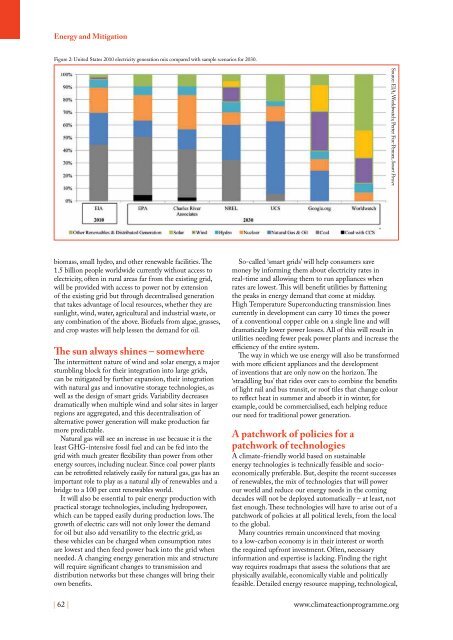Climate Action 2010-2011
You also want an ePaper? Increase the reach of your titles
YUMPU automatically turns print PDFs into web optimized ePapers that Google loves.
Energy and Mitigation<br />
Figure 2: United States <strong>2010</strong> electricity generation mix compared with sample scenarios for 2030.<br />
Source: EIA; Worldwatch; Perter Fox-Penner, Smart Power.<br />
biomass, small hydro, and other renewable facilities. The<br />
1.5 billion people worldwide currently without access to<br />
electricity, often in rural areas far from the existing grid,<br />
will be provided with access to power not by extension<br />
of the existing grid but through decentralised generation<br />
that takes advantage of local resources, whether they are<br />
sunlight, wind, water, agricultural and industrial waste, or<br />
any combination of the above. Biofuels from algae, grasses,<br />
and crop wastes will help lessen the demand for oil.<br />
The sun always shines – somewhere<br />
The intermittent nature of wind and solar energy, a major<br />
stumbling block for their integration into large grids,<br />
can be mitigated by further expansion, their integration<br />
with natural gas and innovative storage technologies, as<br />
well as the design of smart grids. Variability decreases<br />
dramatically when multiple wind and solar sites in larger<br />
regions are aggregated, and this decentralisation of<br />
alternative power generation will make production far<br />
more predictable.<br />
Natural gas will see an increase in use because it is the<br />
least GHG-intensive fossil fuel and can be fed into the<br />
grid with much greater flexibility than power from other<br />
energy sources, including nuclear. Since coal power plants<br />
can be retrofitted relatively easily for natural gas, gas has an<br />
important role to play as a natural ally of renewables and a<br />
bridge to a 100 per cent renewables world.<br />
It will also be essential to pair energy production with<br />
practical storage technologies, including hydropower,<br />
which can be tapped easily during production lows. The<br />
growth of electric cars will not only lower the demand<br />
for oil but also add versatility to the electric grid, as<br />
these vehicles can be charged when consumption rates<br />
are lowest and then feed power back into the grid when<br />
needed. A changing energy generation mix and structure<br />
will require significant changes to transmission and<br />
distribution networks but these changes will bring their<br />
own benefits.<br />
| 62 |<br />
So-called ‘smart grids’ will help consumers save<br />
money by informing them about electricity rates in<br />
real-time and allowing them to run appliances when<br />
rates are lowest. This will benefit utilities by flattening<br />
the peaks in energy demand that come at midday.<br />
High Temperature Superconducting transmission lines<br />
currently in development can carry 10 times the power<br />
of a conventional copper cable on a single line and will<br />
dramatically lower power losses. All of this will result in<br />
utilities needing fewer peak power plants and increase the<br />
efficiency of the entire system.<br />
The way in which we use energy will also be transformed<br />
with more efficient appliances and the development<br />
of inventions that are only now on the horizon. The<br />
‘straddling bus’ that rides over cars to combine the benefits<br />
of light rail and bus transit, or roof tiles that change colour<br />
to reflect heat in summer and absorb it in winter, for<br />
example, could be commercialised, each helping reduce<br />
our need for traditional power generation.<br />
A patchwork of policies for a<br />
patchwork of technologies<br />
A climate-friendly world based on sustainable<br />
energy technologies is technically feasible and socioeconomically<br />
preferable. But, despite the recent successes<br />
of renewables, the mix of technologies that will power<br />
our world and reduce our energy needs in the coming<br />
decades will not be deployed automatically – at least, not<br />
fast enough. These technologies will have to arise out of a<br />
patchwork of policies at all political levels, from the local<br />
to the global.<br />
Many countries remain unconvinced that moving<br />
to a low-carbon economy is in their interest or worth<br />
the required upfront investment. Often, necessary<br />
information and expertise is lacking. Finding the right<br />
way requires roadmaps that assess the solutions that are<br />
physically available, economically viable and politically<br />
feasible. Detailed energy resource mapping, technological,<br />
www.climateactionprogramme.org












